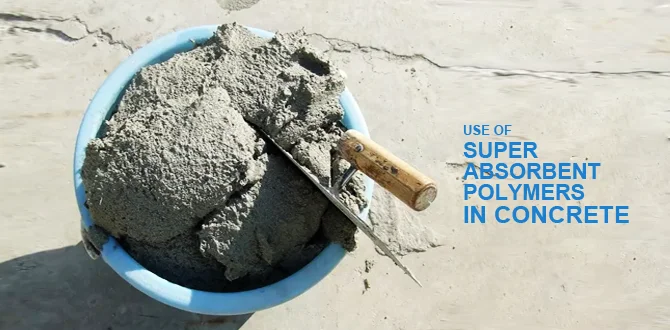Water plays a fundamental role throughout the lifecycle of concrete, from its initial mixing to its hardening and eventual interaction with the environment. However, managing water within concrete is crucial, as it can lead to shrinkage, cracking, and various strength-related issues. Superabsorbent polymers (SAPs) present a promising solution to these challenges by offering unique properties that can actively influence concrete performance.

Internal Water Curing and Strength Enhancement
One of the significant benefits of incorporating SAPs into concrete is their ability to act as internal water reservoirs. This process, known as internal water curing, involves SAPs gradually releasing water into the concrete as it dries out. This continual hydration of cement particles not only promotes the concrete’s strength but also helps control shrinkage. The impact of SAPs on concrete strength varies based on factors such as water-cement ratio (w/c) and the amount of SAP added. Generally, at lower w/c ratios (<0.45), SAP addition can enhance compressive strength by facilitating better hydration. Conversely, at higher w/c ratios, SAPs may lead to reduced strength due to increased void formation within the concrete matrix.
Mitigating Shrinkage and Cracking
Shrinkage-induced cracking is a common issue in both plastic and hardened concrete states. SAPs mitigate this problem by acting as water sources that slow down or prevent water loss. While traditional methods focus on surface-related treatments, SAPs offer an internal approach to manage autogenous shrinkage. This phenomenon, particularly significant in high-performance concrete, can compromise durability and aesthetic appeal. By engineering the water phase distribution within the concrete, SAPs help maintain structural integrity and minimize the risk of cracking.
Improving Frost Resistance
Another critical application of SAPs in concrete is their role in engineering the pore structure. During cement hydration, SAP particles shrink, leaving behind gas-filled voids that can enhance frost resistance by controlling air entrainment. Unlike conventional methods, which face challenges like air loss during vibration, SAPs allow precise control over the air content, bubble spacing, and cavity size within hardened concrete. This engineered air-entrainment not only improves durability against freezing and thawing cycles but also enhances overall structural performance.
Rheology Modification and Practical Applications
Beyond hydration and strength enhancement, SAPs significantly impact the rheology of fresh concrete. Their water-absorbing properties alter the concrete’s yield stress and plastic viscosity, necessitating adjustments in the mix design. This effect is particularly beneficial in wet-mix concreting scenarios where maintaining optimal slump levels is crucial for placement and compaction. The ability of SAPs to adjust viscosity without compromising long-term strength makes them valuable in shotcrete applications, where precise control over air-void structure is essential.
Conclusion
Superabsorbent polymers represent a versatile and effective additive for improving the performance of concrete across various applications. By addressing water management issues such as hydration control, shrinkage mitigation, frost protection, and rheology adjustment, SAPs offer concrete producers and engineers new opportunities to enhance durability, sustainability, and structural integrity. As research continues to explore their full potential, SAPs are poised to play an increasingly vital role in advancing the capabilities of modern concrete technology.
This blog post summarizes the benefits and applications of SAPs in concrete, highlighting their role in addressing water-related challenges and enhancing overall performance. For more information on incorporating SAPs into concrete mixes or exploring their specific applications, contact our team for expert advice and solutions tailored to your project needs.
